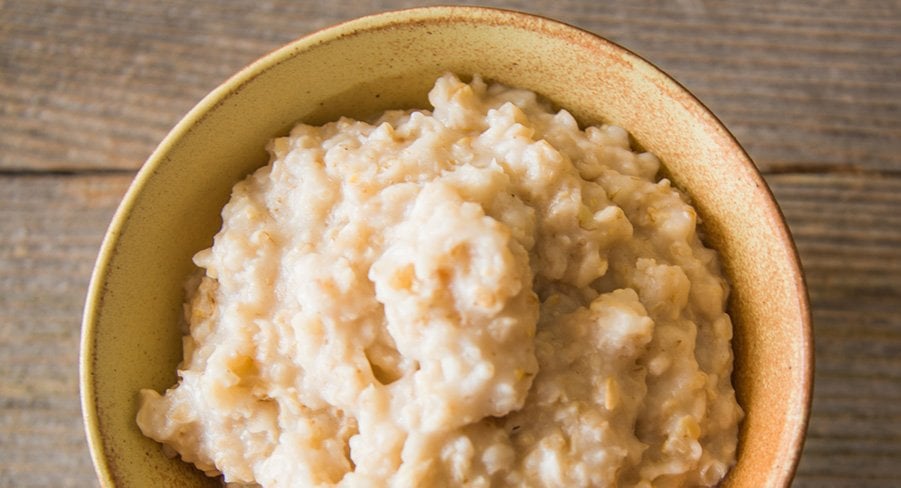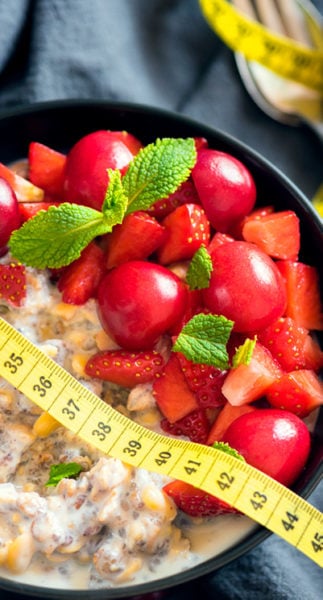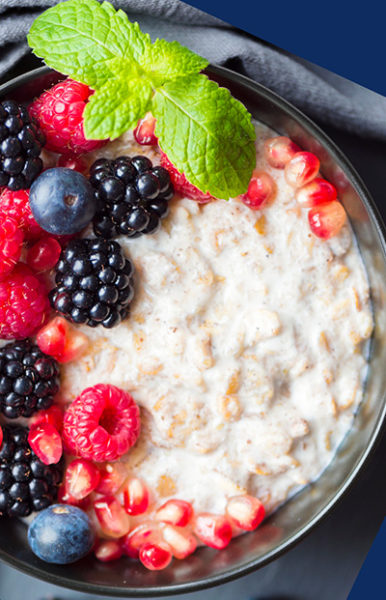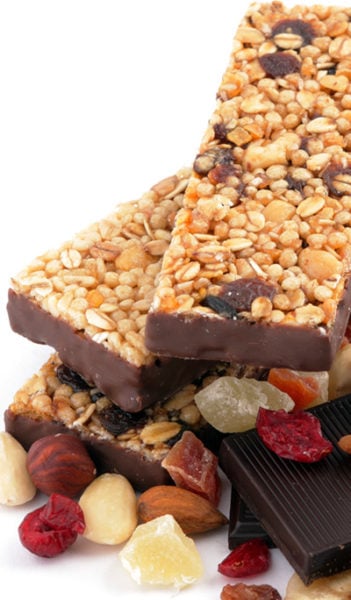Oatmeal Benefits and Tasty Tips
By switching your morning bowl of corn flakes for a bowl of hot oatmeal and fruit, you’ll take in approximately 250 fewer calories each day, which means you’d drop about 25 pounds in one year. Yes, that one small change to your life can yield big benefits.

Oatmeal Benefits
Oatmeal is the breakfast with benefits. Here are five key reasons for enjoying a fragrant, steamy bowl of oatmeal just about every day.
1. Oatmeal helps lower LDL (bad) cholesterol.
Oats are a rich source of soluble fiber. Soluble fiber forms a gel that helps “sweep” cholesterol out of the body, which means less cholesterol ends up in our blood. Many well-designed trials have proven the cholesterol-lowering benefits of oats.1
2. Oatmeal can help improve blood sugar.
Research2 has found that oats help lower blood sugar levels, especially in people who are overweight or have pre-diabetes or type 2 diabetes.
Oats have also been shown3 to improve insulin sensitivity, and that’s a very good thing. If you’re insulin sensitive, it means your body makes very good use of the insulin your body is already producing. Your own insulin, in short, is helping lower your blood sugar levels. You have far less need for “outside” influencers like drugs or insulin shots.
3. Oatmeal can help shed weight.
Oatmeal has “staying power.” Eat a bowl of oatmeal in the morning, and chances are you’re not going to be hungry again for hours. Yes, “staying power” means you’re staying away from those extra calories you used to inhale mid-morning because your stomach was already growling for “something to eat” (especially something from the neighborhood bakery).

The two key things that give oatmeal its stomach-filling satisfaction are its high amounts of fiber and high amounts of water. As the nutritionists at the Pritikin Longevity Center teach in their weight-loss workshops at the health resort, oatmeal is a fiber-rich food that’s also “wet.”
For losing weight, you’re much better off choosing “wet” (cooked in water) breakfasts like oatmeal than “dry” breakfasts like breads, bagels, breakfast bars, and dry cereals, even whole-grain varieties.
A bowl of oatmeal topped with nonfat (skim) milk and berries has about the same number of calories (270) as a typical cereal bar. But let’s face it: Those cereals bars are small. In three or four bites, they’re gone. Within a couple of minutes, a lot of us could easily put away three bars. Three bowls of oatmeal? No chance.
So yes, those cereal bars may be quick and easy food, but eat them till you’re comfortably full every day, and you’ll likely end up with quick and easy weight gain.
Not only do “wet” choices like oatmeal fill you up better, you’re also taking in, bite per bite, about one-third the calories. By switching your morning bowl of corn flakes for a bowl of hot oatmeal and fruit, you’ll take in approximately 250 fewer calories each day, which means you’d drop about 25 pounds in one year. Yes, that one small change to your life can yield big benefits.
4. Oatmeal is a nutritional powerhouse.
We’ve talked about the fiber in oatmeal, but did you know that oatmeal is also a good source of protein? In fact, research4 has found that oats have more protein than virtually every other grain.
Oats are also packed with loads of important vitamins, minerals, and anti-oxidants. Put simply, oats are among the most nutrient-dense foods on earth.
With just one-half cup of oats (pre-cooked), you get:
- Manganese: 191% of the RDI (Recommended Daily Intake)
- Phosphorus: 41% of the RDI
- Vitamin B1: 39% of the RDI
- Magnesium: 34% of the RDI
- Copper: 24% of the RDI
- Iron: 20% of the RDI
- Zinc: 20% of the RDI
- Folate: 11% of the RDI
- Vitamin B5: 10% of the RDI
- Plus some calcium, potassium, vitamin B6, and vitamin B3
Wow!
5. Oats may help relieve constipation.
That’s no small benefit, especially in a country like America, which is often described, based on our prodigious use of laxatives, as the most constipated nation on earth.
Research5 has shown that a daily serving of oat bran for three months helped relieve constipation so effectively among elderly men and women that nearly 60% of them no longer needed laxatives.
Oatmeal | Different Types
Stroll through the oatmeal aisle at the market, and you’re bound to wonder, “Where to begin?” There are seemingly endless varieties of oatmeal to choose from.
Here’s a quick, cut-through-the-confusion summary:
-
Rolled oats (also called old-fashioned oats):
Rolled oats means that the oats have been flattened with large rollers and turned into flakes.
Read the prep instructions on the box or bag for whichever type of oats you choose. Generally, rolled oats take about 5 minutes to cook on the stovetop, and about 2½ to 3 minutes in the microwave.
-
Quick-cooking oats (also called instant oats):
These oats are rolled thinner and cut into pieces. They need just a minute or less on the stovetop or microwave, or simply a cup of boiling water poured over the oats.
“But do read the Nutrition Label and Ingredient List of any oatmeal you buy, especially single-serving packets of instant oatmeal,” cautions Kimberly Gomer, MS, RD, Director of Nutrition at the Pritikin Longevity Center. “In their natural state, oats are whole grain and free of salt and sugar. But with many packets of instant oatmeal, you’ll often see that all kinds of sugar and salt have been added.”
“Optimally,” recommends Kimberly, “all you want to see in the Ingredient List is one ingredient – oats, or more specifically, 100% whole-grain oats.”
-
Steel-cut oats (also called Irish oats or Scotch oats):
Steel-cut oats are not rolled. Instead, they are cut into pieces with steel blades. They take longer to cook, about 25 minutes on the stove. Taste-wise, they’re often described as creamier and chewier than rolled oats. Some quicker-cooking varieties of steel-cut oats are now available on the market.
 Get suggestions for tasty toppings, like fresh berries and a few crunchy pomegranate seeds.[/caption]
Get suggestions for tasty toppings, like fresh berries and a few crunchy pomegranate seeds.[/caption]
Choose your “wet”
Cook your oatmeal in water, or if you prefer, nonfat milk or soymilk.
Cook up a big batch that lasts the whole week
No time on weekday mornings? No problem.
When Pritikin dietitian Kimberly Gomer knows she has a busy week ahead of her, she gets busy on Sundays. She cooks oatmeal in a large pot with either water, skim milk, or soymilk and mixes in lots of frozen berries. “All I have to do for the next five mornings is scoop some out and heat it in the microwave for a minute. That’s it!”
Starbucks to the rescue
Rushing out the door?
At the airport terminal at 6 am?
Stop off at Starbucks for their Classic Oatmeal, a combination of rolled and steel-cut oats. If you’re watching your weight, don’t open the dried fruit, nut, or brown sugar packets.
Another great choice at Starbucks is Hearty Blueberry Oatmeal. It’s a rolled and steel-cut combo, plus a nice little packet of fresh blueberries that you pour into your oatmeal. (Don’t open the agave syrup. Agave is just a fancy name for sugar.)
Chilled oats
You heard us right. You may wince at the thought, but chilled oats are actually quite tasty. Plus, they’re ready-to-go out the door with you come morning. And they’re a nice, refreshing change during the summer season.
At night, simply mix together in a large bowl a 6-ounce carton of plain, nonfat yogurt, 2/3 cup regular rolled oats, and 2/3 cup nonfat milk. Stir in any variety of your favorite toppings.
Pour the mixture into two single-serving 8-ounce canning jars – for example, half-pint Mason jars.

Cover the jars, and chill in the fridge overnight, or up to 3 days. You’ll discover that your oats will become lusciously rich and creamy.
Oatmeal | How a Good Food Can Sometimes Go Bad
We all know that a Oatmeal Raisin Cookie from the mall isn’t going to score high for healthy nutrition, not to mention our weight-loss efforts. (Each cookie packs in 200 calories.)
But you can run into trouble with so-called “healthy” foods, too. A supermarket Oatmeal Square With Peanut Butter, for example, ratchets up 160 calories and 9 grams of sugar. (That’s more than one-third the daily sugar limit recommended by the American Heart Association6 for women, and one-quarter the limit for men.)
-
Mere morsels
And, as we discussed earlier, all you’re getting with these “energy bars” and breakfast squares is a morsel of food. In three or four bites, it’s all over. So, is it any surprise you’re still hungry (or hungry just an hour later), craving more to eat?
-
Added sugars
The same good-food-turned-bad story can happen with oatmeal itself. As pointed out earlier, single-serving packets of some instant oatmeal can load you up with 12 grams of sugar, and more.
“That’s why it’s so important to read the Nutrition Facts and Ingredient List,” says Dr. Danine Fruge, MD, Medical Director at the Pritikin Longevity Center. “A fiber-rich food like oatmeal isn’t going to do you much good if it’s also rich with refined sugars. And be careful of ingredients that sound healthy but are really just plain old sugar, like honey, molasses, agave syrup, rice syrup, and malted barley.”
-
Salt
And while a supermarket “Weight Control Instant Oatmeal” gets credit for substituting sucralose (Splenda) for added sugars, each packet is still full of salt – 260 milligrams of sodium. That’s nearly one-fifth the total daily limit of sodium that the American Heart Association, Centers for Disease Control, and Pritikin Eating Plan recommend as optimal for most Americans. It’s a lot of sodium, especially for a food – oatmeal – that no one would ever think of as needing salt.
Oatmeal Recipes
“Oatmeal reigns king at our breakfast buffet at the Pritikin Longevity Center,” smiles Kimberly Gomer. “But it’s not just any old oatmeal. Our chefs serve up big, tantalizing pots of their own award-winning creations, like Oatmeal Supreme.
“And in our daily cooking classes guests learn how to make what they’ve enjoyed in our dining room in their own kitchens back home.”
And certainly, it’s not just oatmeal for breakfast at Pritikin. The dining room is ablaze with the reds, purples, oranges, blues, and greens of tropical fruit treats like mangoes and papayas, plus strawberries, raspberries, blueberries, and melons.
Also in the Pritikin breakfast dining room is an egg-white omelete bar with selections like salsa, fresh grilled asparagus, and nonfat ricotta cheese. Plus sweet potato pancakes with spiced apple compote. Plus a hot and cold cereal bar with, in addition to Oatmeal Supreme, freshly cooked selections like kasha, Strawberry Quinoa Oatmeal, and Orange-Vanilla Oatmeal.
Good Food, All Day
That’s just breakfast. Hearty homemade soups like minestrone and corn chowder are served for midmorning and afternoon snacks. Lunches and dinners include huge salads; entrees like grilled bison, pasta primavera, and roasted lobster; and desserts like chocolate mousse (made with dark chocolate and whipped tofu).
Oatmeal | “…a perfect meal”
But it all begins with that simple bowl of oatmeal. “It’s all about making the first meal of the day a perfect meal,” sums up Dr. Fruge.
“At Pritikin, our guests learn that perfection is not only hearty, healthy, and slimming, it’s delicious.”
Sources
- 1 American Journal of Clinical Nutrition, 2014; 100 (6): 1413.
- 2 Molecular Nutrition and Food Research, 2009; 53 (3): 361.
- 3 Nutrients, 2015; 10: 7 (12): 10369.
- 4 Critical Reviews In Food Science and Nutrition, 2012; 52 (7): 629.
- 5 The Journal of Nutrition, Health and Aging, 2009; 13 (2): 136.
- 6 American Heart Association: Daily Sugar Limits